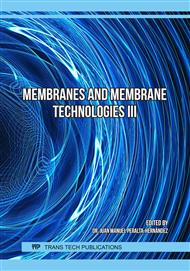p.127
p.135
p.143
p.151
p.159
p.167
p.173
p.179
p.185
Oil Palm Empty Bunches Adsorber Membrane for CO2 Reduction of Biogas TPA Gunung Kupang in South Borneo
Abstract:
Biogas is one of the renewable energy alternatives. The heat of burning biogas depends on the percentage of CH4 (methane) gas and CO2 (carbon dioxide) gas. Biogas with high impurity gas components, such as CO2 and H2S (hydrogen sulfide), can cause a decrease in heating value. Therefore, purification efforts are needed. The adsorber membrane was successfully made from oil palm empty fruit bunches (OPEFB) which were pyrolyzed as physical activation. The adsorber membrane is activated to form a porous structure and a usable surface area for gas separation. This study aims to see the effect of variations in the carbon weight of OPEFB on reducing CO2 levels in the Gunung Kupang landfill biogas. Preparation of OPEFB adsorber membrane by mixing PVA (polyvinyl alcohol) and PEG (polyethylene glycol) polymers into OPEFB with varying weights, namely 12.5, 15, and 17.5 g (grams). Membrane performance is determined based on the results of the flame test and gas chromatography test results. Based on the results of the flame test of the biogas that has been passed on the adsorber membrane, overall all samples showed a predominantly bright blue flame color. Meanwhile, the chromatographic test results showed a decrease in CO2 levels in samples of 12.5, 15, and 17.5 g, respectively 19.6%, 32.02%, and 61.58%. The results of the flame test and gas chromatography test prove that the difference in mass weight affects the performance of the samples tested where the greater the mass of adsorber membrane used, the greater the increase in absorbed CO2 gas content.
Info:
Periodical:
Pages:
159-164
Citation:
Online since:
March 2022
Authors:
Keywords:
Price:
Сopyright:
© 2022 Trans Tech Publications Ltd. All Rights Reserved
Share:
Citation:



